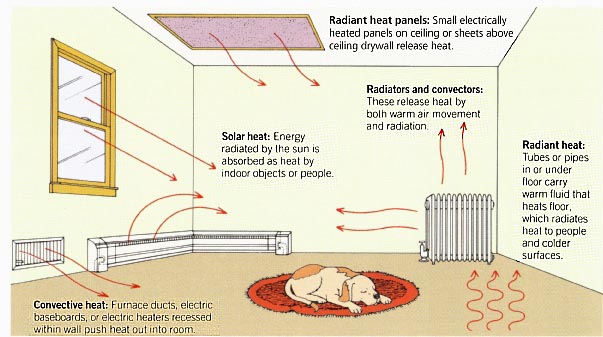
| HOME | Prev: Dryer Vents and Heat-recovery Ventilators | Next: Forced Air |
Heating systems convert fuel or energy into heat and distribute it throughout the house. Regardless of the type, they all do the same job: keep our homes warm and comfortable. Heating systems differ mainly in the fuels they use and in the ways they generate and distribute the heat.
The most common whole-house systems are warm air and hot water. In
both cases, air or a liquid is heated in a furnace or boiler and sent
to the various parts of the house through ducts, pipes or tubes. The
heated air in a warm-air system is blown into the rooms through ducts and registers. In hot-water systems, water or steam heats radiators,
convectors or even the house’s floors, ceilings or walls; these in
turn give off their heat to the rooms. The furnace of a warm-air system and the boiler in the other systems have a burner that can be fueled
by gas, oil, propane, butane, electricity, even wood or coal, depending
upon their availability and the local preference. Other systems heat
the home entirely by electricity, as in electrical radiant heat and baseboard convectors.
Heat pumps extract heat from outside air and pump it indoors. Solar panels, fireplaces, wood-burning stoves and space heaters are also used. Generally, these heat sources provide auxiliary heat to supplement a whole-house system, although they may be all you need in warmer climates where only occasional heating is required.
One or more thermostats control a whole-house system. The thermostat may also perform other functions, such as controlling the forced-air system blower fans or hot-water system valves.

Above:
Radiant heat panels: Small electrically heated panels on ceiling or sheets above ceiling drywall release heat.
Radiators and convectors: These release heat by both warm air movement and radiation.
Radiant heat: Tubes or pipes in or under floor carry warm fluid that heats floor, which radiates heat to people and colder surfaces.
Solar heat: Energy radiated by the sun is absorbed as heat by indoor objects or people.
| System | Heat Delivered By | Most Common Fuels | Means of Distribution | Pros | Cons |
| Warm air | Forced convection blower | Natural gas, fuel oil, propane, or electricity | Ductwork from furnace, electric heaters mounted on exterior walls or recessed into interior walls. | Can also filter, humidify and air-condition. Rooms heat quickly. Wall heaters are inexpensive. | Large ductwork required. Fans can be noisy, can circulate mold and other allergens. Require regular filter changes. |
| Hot water | Convection or convection and radiation | Natural gas fuel oil propane or Electricity | Pipes and convectors or radiators. | Efficient and quiet. Holds steady temperatures. Boiler can be small. | Slower temperature rise Radiators or convectors take floor or wall space. |
| Steam | Convection, or convection and radiation. | Natural gas, fuel oil, propane, or electricity | Pipes and radiators. | Efficient and hot. Warms rooms quickly. Boilers can be small. | Can be noisy. Radiators can be hot to the touch. Boiler systems are tricky to maintain. |
| Radiant heat | Radiation or radiation and convection. | Gas oil propane butane for floor systems; electricity for ceiling systems and exposed panels wood and coal for stoves. | Pipes or tubes in or under floors wiring within plaster or above wall- board panels mounted on ceilings or walls firebox and flue pipe for stoves | Quiet even heating Embedded systems make floors pleasantly warm. Hydronic systems can use most efficient energy source or fuel | Slow to warm up and cool down Expensive to install initially. Embedded elements or pipes are very difficult to repair. |
| HOME | Prev: Dryer Vents and Heat-recovery Ventilators | Next: Forced Air |
Updated: Friday, February 21, 2020 18:24 PST